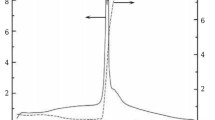Conclusions
-
1.
Determinations were made of the amounts of Si, Al, Ti, Cr, Mn, Fe, Ni, O, and N in zirconium carbide batches produced by the reaction of zirconium oxide with carbon in a vacuum (Dnepropetrovsk Chemical Reagents Factory) and in a reducing gas atmosphere (Special Design and Technology Department, Institute of Materials Science, Academy of Sciences of the Ukrainian SSR), by synthesis from the simple substances in a vacuum (Institute of Materials Science, Academy of Sciences of the Ukrainian SSR), and by self-propagating high-temperature synthesis. The total amounts of impurities in all the batches were found to be of the same order.
-
2.
It has been ascertained that many of the impurities in zirconium carbide produced by the methods investigated occur as free metals and compounds soluble in hydrochloric acid, and their amounts can therefore be substantially reduced by appropriate treatment.
-
3.
According to literature data, the amounts of oxygen and nitrogen in zirconium carbide can be decreased by raising the synthesis temperature above 2000°C.
Similar content being viewed by others
Literature cited
A. K. Babko and A. T. Pilipenko, Colorimetric Analysis [in Russian], Goskhimizdat, Moscow (1951).
Z. S. Mukhina and E. I. Nikitina, Accelerated Methods of Analysis of Titanium and Its Alloys [in Russian], Oborongiz, Moscow (1961).
V. P. Kopylova, “A study of some chemical properties and development of methods for the chemical analysis of the disilicides of Groups IV, V, and VI transition metals,” Candidate's Dissertation, Kiev (1971).
V. I. Rakcheeva, L. A. Mashkovtch, et al., “Reactions of zirconium and silicon in the presence of excess carbon,” Poroshk. Metall., No. 5, 57–61 (1972).
H. J. Goldschmidt, Interstitial Alloys, Plenum Publ. (1968).
G. M. Klimashin, A. I. Avgustinik, and T. V. Smirnov, “Carbonitride and oxycarbide phases of titanium and zirconium,” Izv, Akad. Nauk SSSR, Neorg. Mater.,8, No. 5, 843–845 (1972).
T. Ya. Kosolapova, V. B. Fedorus, and Yu. B. Kuz'ma, “Reactions of carbides of transition metals with their oxides,” Izv. Akad. Nauk SSSR, Neorg. Mater.,2, No. 8, 1516–1520 (1966).
Author information
Authors and Affiliations
Additional information
Translated from Poroshkovaya Metallurgiya, No. 8(188), pp. 1–4, August, 1978.
Rights and permissions
About this article
Cite this article
Popova, O.I., Kosolapova, T.Y. Impurities in zirconium carbide powders produced by various methods. Powder Metall Met Ceram 17, 573–575 (1978). https://doi.org/10.1007/BF00797326
Received:
Issue Date:
DOI: https://doi.org/10.1007/BF00797326




